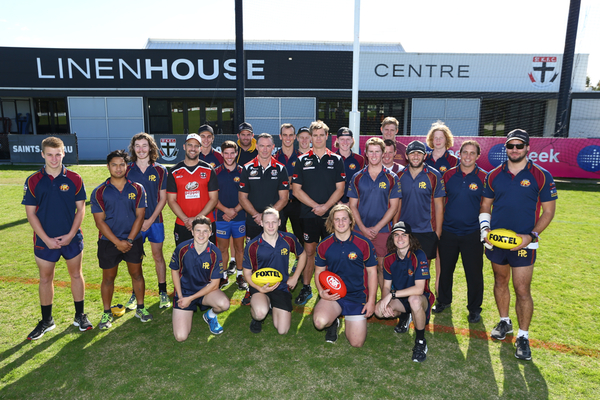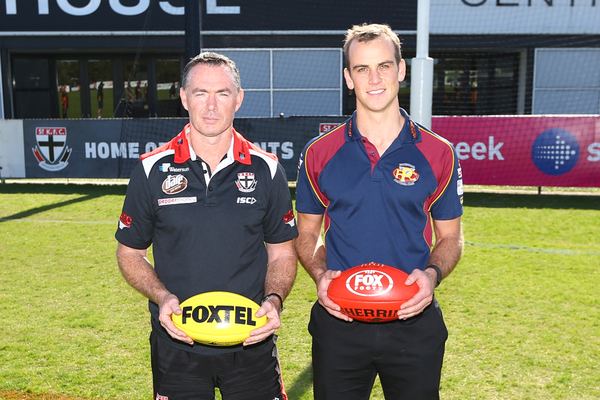By CASEY NEILL
PAKENHAM Football Club has got a taste of the big time and plenty of tips to improve their game.
The Lions had a day-in-the-life-of experience with St Kilda Football Club at Linen House Centre in Seaford on Wednesday 4 May.
It was part of their Fox Footy Community Club of the Year win for community work including holding the Cardinia Relay for Life and Cardinia Shire Christmas Carols, and contributing to fund-raising for MND Foundation, beyondblue, Zaidee’s Rainbow Foundation and the White Ribbon Foundation.
The Lions’ football director Simon Bevan nominated the club for the award.
“St Kilda were fantastic. They opened up the whole club to us,” he said.
“They gave a lot of the guys a lot of tips – different things to look for in a game, how to break a tackle – things we wouldn’t really know at local level.”
The club took 32 players on the day, with six tied up at work following the wild weather on Tuesday.
Bevan particularly valued the time with the Saints’ senior coach Alan Richardson.
“He commended the Pakenham footy club on their work in the community,” he said.
“He mentioned how he’d been a coach at East Burwood after his AFL playing career, so he understands the difficulties of local football clubs.
“When you’re at local clubs you don’t have everything so you’ve just got to adapt.”
Saints coaches put Lions through their paces.
Running the day was Saints coaching director Danny Sexton, who is part of a team of 10 supporting Richardson.
The Lions also met backline coach Rohan Welsh, forward line-focused Aaron Hamill, midfield coach Adam Kingsley, and Lindsay Gilbee, a backline coach who runs the club’s kicking program.
Sexton ran through the Saints’ schedule for the week, from meetings to training drills, recovery and free time.
“They’re the types of thing that a real AFL player sits through,” he said.
“We haven’t doctored anything up.”
He led a Linen House tour, which included an indoor basketball court, a cold pool for recovery, and a gym bursting with equipment and motivational messages.
Sexton explained that the players completed a recovery session of up to 40 minutes following each training session.
“It’s not just off the training track and on to lunch,” he said.
Several Pakenham players commented that the club’s ‘honour roll’ corridor was a great idea.
The walls were adorned with the names and photos of award-winners, coaches, captains and Hall of Fame members, plus a list of every past and present player.
“This is really good for our players to go through every day,” Sexton said.
“They get a sense of what went before them.”
Mounds of bananas, grapes and mandarins are piled on tables in the dining area, which services 60 staff and 40 players.
Sexton explained that the altitude room was used heavily during preseason, often with the heaters cranked up, and that new parents and guys killing time could snooze in a bedroom space, or catch up on homework.
A sandpit for pre-season wrestling and a cherry picker beside the oval was among the more unusual equipment.
“There’s usually two cameras on the cherrypicker every training session and then the coaches can use the vision to educate their players,” Sexton said.
Hamill spoke about the mechanics in the coaches’ box.
“It’s an emotional place,” he said.
He almost exclusively watches the forward line, searching for ways to make the most of forward entries.
“Probably the most important part of our role is coming up with solutions,” he said.
“We’re the first line of defence.
“We don’t want to defend in our back half unless we have to.”
In response to questions from the Lions, Hamill explained that he would change one moving part independently but would run bigger picture changes through Richardson.
He said players quite often “get it done” without a message even being sent down to them.
“They know how we want to play and how we want to move the ball,” he said.
Stats guys sit in the back of the box throwing out numbers, and each line coach can chip in with suggestions for any part of the ground.
“We all want the same outcome,” he said.
Welsh coached at TAC level for 10 years.
“There’s as much development done at this level as there was at that level,” he said.
He explained that the coaches worked out how they wanted the players to perform, identified the fundamental plays and skills to make that happen, then worked out how to get the guys there.
“The really good defenders in the comp read the cues,” he said.
So they showed the players videos and asked what they would do in the scenario, then ran them through different drills on the oval.
The Lions players hit the basketball court with Kingsley, focusing on clean hands and ball security.
“Hug the ball and protect it,” Kingsley instructed, also demonstrating how to throw in a “chop” with their forearm to fend off the tackle.
Gilbee covered kicking to advantage, cues and more during drills on the oval, and backline player Jesse Pantorno took out a goal-kicking challenge that showed the side had a bit of work to do on the skill.
Opposition analyst Robbie Chancellor explained how he watched games three times from different angles and to come up with plans to stop the opposition.
Lions player James Pela said the Saints coaches broke down instinctive actions and provided ways to hone the skills.
“When you hear it from someone professional you definitely take it all in,” he said.
Sexton said Pakenham could take away plenty from the day.
“It’s basic stuff that the AFL players would work on a lot,” he said.
“That drill they just did inside was essentially just a handball drill with a little bit of pressure and somebody coming at you, so that could be replicated at community level.
“A community footballer might not touch the balls as much as an AFL player, but if they wanted to improve their footy they could definitely touch the footies more.
He said the Saints would take plenty away from the day, too.
“It’s good to go back to where it all started for a lot of the coaches,” Sexton said.








